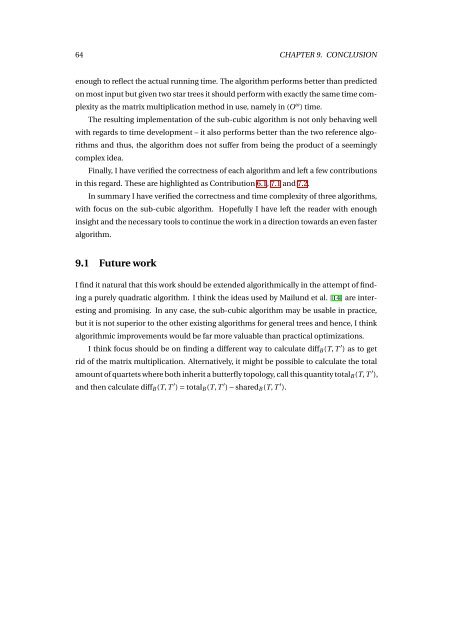computing the quartet distance between general trees
computing the quartet distance between general trees
computing the quartet distance between general trees
Create successful ePaper yourself
Turn your PDF publications into a flip-book with our unique Google optimized e-Paper software.
64 CHAPTER 9. CONCLUSIONenough to reflect <strong>the</strong> actual running time. The algorithm performs better than predictedon most input but given two star <strong>trees</strong> it should perform with exactly <strong>the</strong> same time complexityas <strong>the</strong> matrix multiplication method in use, namely in (O ω ) time.The resulting implementation of <strong>the</strong> sub-cubic algorithm is not only behaving wellwith regards to time development – it also performs better than <strong>the</strong> two reference algorithmsand thus, <strong>the</strong> algorithm does not suffer from being <strong>the</strong> product of a seeminglycomplex idea.Finally, I have verified <strong>the</strong> correctness of each algorithm and left a few contributionsin this regard. These are highlighted as Contribution 6.1, 7.1 and 7.2.In summary I have verified <strong>the</strong> correctness and time complexity of three algorithms,with focus on <strong>the</strong> sub-cubic algorithm. Hopefully I have left <strong>the</strong> reader with enoughinsight and <strong>the</strong> necessary tools to continue <strong>the</strong> work in a direction towards an even fasteralgorithm.9.1 Future workI find it natural that this work should be extended algorithmically in <strong>the</strong> attempt of findinga purely quadratic algorithm. I think <strong>the</strong> ideas used by Mailund et al. [14] are interestingand promising. In any case, <strong>the</strong> sub-cubic algorithm may be usable in practice,but it is not superior to <strong>the</strong> o<strong>the</strong>r existing algorithms for <strong>general</strong> <strong>trees</strong> and hence, I thinkalgorithmic improvements would be far more valuable than practical optimizations.I think focus should be on finding a different way to calculate diff B (T,T ′ ) as to getrid of <strong>the</strong> matrix multiplication. Alternatively, it might be possible to calculate <strong>the</strong> totalamount of <strong>quartet</strong>s where both inherit a butterfly topology, call this quantity total B (T,T ′ ),and <strong>the</strong>n calculate diff B (T,T ′ ) = total B (T,T ′ ) − shared B (T,T ′ ).
















